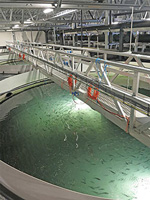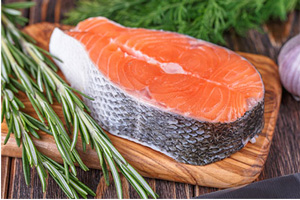By John Saulnier, FFB Editorial Director
 Maynard, Massachusetts-headquartered AquaBounty Technologies is applauding the US Food and Drug Administration’s (FDA) March 8 decision to lift a 2016 import ban that has prevented it from bringing genetically engineered salmon eggs into the United States from Prince Edward Island to lay the groundwork for farming and selling AquAdvantage brand salmon in North America’s largest market.
Maynard, Massachusetts-headquartered AquaBounty Technologies is applauding the US Food and Drug Administration’s (FDA) March 8 decision to lift a 2016 import ban that has prevented it from bringing genetically engineered salmon eggs into the United States from Prince Edward Island to lay the groundwork for farming and selling AquAdvantage brand salmon in North America’s largest market.
The company’s shares on the Nasdaq stock exchange in New York more than doubled to $4.89 on the day of the announcement. While still trading below the 52-week high of $5.45, it was well above the lowly $1.51 depth plumbed at one point during the past year. When the market closed on March 12 the price was quoted at $3.48.
“As FDA notes in this announcement, our salmon was approved by the agency over three years ago based upon a very comprehensive science-based review process which established that it was safe, nutritious, environmentally sound and met all other regulatory requirements,” said AquaBounty CEO Sylvia Wulf. “We will immediately start the process to import AquAdvantage eggs from our hatchery in Canada to begin grow-out at our Indiana facility.”
 The land-based indoor recirculating aquaculture system (RAS) near Albany has production capacity of 1,200 tons per year and was designed to allow for significant expansion. The site is situated within a few hours’ drive time of major metropolitan markets in Indianapolis, Chicago, Detroit, Cleveland, Columbus, Louisville and St. Louis.
The land-based indoor recirculating aquaculture system (RAS) near Albany has production capacity of 1,200 tons per year and was designed to allow for significant expansion. The site is situated within a few hours’ drive time of major metropolitan markets in Indianapolis, Chicago, Detroit, Cleveland, Columbus, Louisville and St. Louis.
In the early 1990s the biotechnology company, a majority-owned subsidiary of Intrexon Corporation, developed a growth regulator bypass technique to shorten the typical salmon production cycle of 28-36 months to 16-18 months to grow its proprietary breed of fish to harvest size approximately 50% faster than traditionally reared Atlantic salmon. The process involves the insertion of genes from chinook salmon and eel-like ocean pout. Thousands of pounds of such farm-raised fish have already been sold unlabeled to sushi markets in Canada.
 Noting that approximately 350,000 tons of Atlantic salmon are consumed annually in the United States, of which more than 95% is imported, Wulf said: “FDA’s actions will allow for production and sale to begin here in the US, bringing opportunity for investment in rural America, creating American jobs, while also reducing dependence on seafood imports.”
Noting that approximately 350,000 tons of Atlantic salmon are consumed annually in the United States, of which more than 95% is imported, Wulf said: “FDA’s actions will allow for production and sale to begin here in the US, bringing opportunity for investment in rural America, creating American jobs, while also reducing dependence on seafood imports.”
In a statement issued to investors, the company declared: “The United States has been a world leader in biotechnology and food innovation, and the FDA’s decision helps to advance our leadership in this critical space. This decision is an important achievement not just for AquaBounty, but also for biotechnology and agricultural innovation in general. As both FDA and USDA have recognized, animal and plant biotechnology enable the development of innovative and transformational products that have the potential to increase sustainable production of food, enhance human nutrition, and help feed a rapidly growing global population.”
Labeling Issue Labeling remains a significant and controversial issue among a number of environmental, consumer and fishing groups. In 2015 Alaska Senator Lisa Murkowski filed an appropriations bill rider that blocked the FDA from approving GE salmon products for sale in the United States until after publication of labeling guidelines by the government spelling out that the fish has been engineered with DNA from another species.
Labeling remains a significant and controversial issue among a number of environmental, consumer and fishing groups. In 2015 Alaska Senator Lisa Murkowski filed an appropriations bill rider that blocked the FDA from approving GE salmon products for sale in the United States until after publication of labeling guidelines by the government spelling out that the fish has been engineered with DNA from another species.
“The new guidelines don’t require adequate mandatory labeling, don’t require calling the fish ‘genetically engineered,’ and don’t help consumers know what kind of fish they are buying,” complained George Kimbrell, legal director at the Washington, DC-based Center for Food Safety (CFS). “These guidelines don’t require mandatory labeling of GE salmon, and instead allow producers to use QR codes or 1-800 numbers for more information. That clearly is not what the Murkowski amendment requires.”
Kimbrell added that that the CFS is considering possible legal actions to force the FDA to comply with the Murkowski amendment and to challenge whether the FDA “even has the legal authority to approve this genetically engineered fish as a new animal drug.”
Harvest in 18 Months The first harvest of AquAdvantage Salmon is scheduled for September of 2020. It is expected that restaurants and other foodservice outlets will be targeted initially, with retail store penetration in view further down the road as production ramps up.
The first harvest of AquAdvantage Salmon is scheduled for September of 2020. It is expected that restaurants and other foodservice outlets will be targeted initially, with retail store penetration in view further down the road as production ramps up.
The carbon footprint reduction advantage of regional short-haul distribution runs from the grow-out facility in Indiana to regional markets relative to long-haul transport of imported farmed salmon from Norway and Chile will no doubt be emphasized by AquaBounty. At the same time, one can expect a number of NGOs to promote boycotts of AquAdvantage Salmon at supermarkets and grocery stores.
“More than 80 retailers have already said they won’t sell this risky, unlabeled GMO fish, and polls show consumers don’t want it,” according to Dana Perls, senior food policy campaigner with Friends of the Earth.
Meanwhile, the wild-caught salmon production sector in Alaska does not seem overly concerned about the impact of competition that AquaBounty may pose.
“We see that as just another farmed seafood product, and we’ve been competing against farmed salmon in the marketplace for several decades now,” said Jeremy Woodrow, executive director of the Alaska Seafood Marketing Institute. “Wild, natural, sustainable – those are attributes that really only apply to Alaska salmon, wild-harvested salmon, and that sets us apart in the marketplace.”




